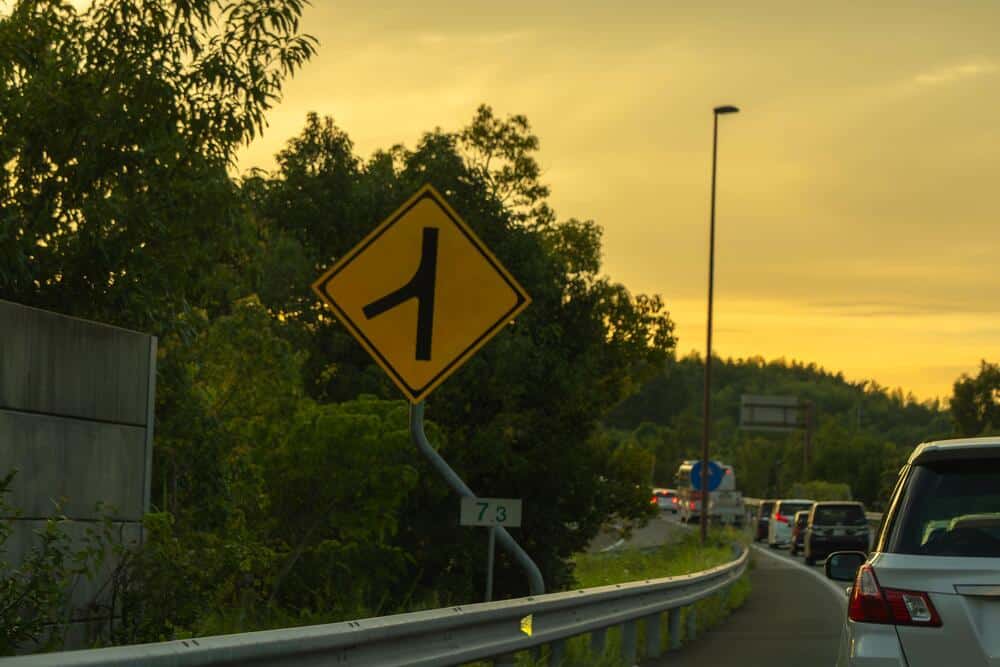Merging Car Accidents in Baltimore, Maryland

Merging car accidents in Baltimore, Maryland, are a common occurrence, particularly at highway entrances where traffic flows converge. These accidents often result in significant disputes over fault, primarily centered around the actions of the merging driver.
In merging accidents, the merging driver is typically deemed at fault, even if another vehicle collides with them during the merge. This is because the merging driver has several critical responsibilities, such as yielding the right-of-way to vehicles already in the lane and ensuring a clear path.
The merging driver’s duties also include checking blind spots, signaling their intentions to merge, and judging the proper space and speed for a safe merge. Failure to fulfill these responsibilities can lead to accidents, often placing the merging driver at fault.
Understanding the dynamics of these types of car accidents in Baltimore, Maryland, is crucial for all drivers. Properly assessing the situation and executing a safe merge can prevent accidents and the associated complications.
What Are Some Common Types of Merging Accidents in Baltimore, Maryland?
Merging car accidents can occur in various scenarios, each with unique risks and challenges. Below are some common types of merging accidents that happen in Baltimore.
Merging Between Lanes
Accidents frequently occur when drivers transition between lanes without proper communication and awareness. Common issues include:
Failure to Signal: Not using turn signals leads to confusion and unexpected lane changes, increasing the likelihood of collisions.
Blind Spot Neglect: Overlooking blind spots can conceal neighboring vehicles, resulting in sudden crashes.
Road Rage: Aggressive driving behaviors can escalate the risks associated with merging turning routine lane changes into dangerous encounters.
Merging from On/Off Ramps
Transitioning from on or off ramps onto main roads like highways presents its own set of challenges:
Speed Dynamics: Mismatched speeds between merging and existing traffic can cause significant accidents.
Space Constraints: Limited merging space often leads to abrupt lane changes, raising the risk of collisions.
Timing and Awareness: Proper timing and awareness of surrounding traffic are critical but often lacking, leading to accidents.
Merging in Work Zones
Work zones add complexity to merging due to altered road conditions and reduced lane space:
Speeding: Excessive speeds in work zones endanger both drivers and workers.
Distracted Driving: Shifting focus away from the road amid changing patterns significantly increases accident risks.
Abrupt Lane Changes: Sudden lane changes in these areas can cause severe crashes.
Merging in Roundabouts
Roundabouts require a specific set of merging skills due to their unique traffic flow:
Failure to Yield: Not yielding to vehicles already in the roundabout disrupts the traffic flow, causing accidents.
Incorrect Lane Usage: Choosing the wrong lane complicates the merging process and increases collision risks.
Improper Signaling: Failing to signal intentions creates confusion and raises the likelihood of crashes.
Braking Truck Collisions
When a driver merges in front of a truck without sufficient caution:
Panic Braking: The truck driver may slam on the brakes, risking skidding, loss of control, or jackknife accidents due to the truck’s weight.
Front- and Rear-End Collisions
Misjudging the space and speed of the traffic can lead to:
Rear-End Collisions: The merging vehicle could collide with the rear of another car or cause another vehicle to hit its rear end, leading to significant damage and injuries.
Blind Spot Collisions
Failing to thoroughly check blind spots before merging:
Unexpected Collisions: This oversight can result in the merging vehicle crashing into another vehicle that was not visible in the blind spot.
What is a “Sideswipe” Accident?
Though it may sound minor, a sideswipe accident can lead to significant loss of vehicle control and potentially severe consequences. A sideswipe collision, defined as a lateral impact between vehicles traveling parallel, often occurs when one vehicle strays into the adjacent lane. This seemingly minor impact can cause one or both drivers to lose control, leading to more serious accidents involving multiple vehicles, including cars, trucks, or motorcycles.
Causes and Consequences
Many sideswipe accidents occur when a driver overreacts to a road hazard or an impending collision, causing their vehicle to strike the side of an adjacent car. Alternatively, sideswipes can happen when drivers change lanes without ensuring the adjoining lane is clear. These actions can send the victim’s vehicle off the road into stationary objects like trees or poles.
Sideswipe collisions can cause significant injuries. The sudden side-to-side jerking motion during a sideswipe can lead to injuries in the shoulders and neck. Unfortunately, insurance companies may dispute injury claims from sideswipe accidents, requiring a clear understanding of the accident’s physics for a successful claim.
Distractions such as texting, phone use, fatigue, changing radio stations, or driving under the influence frequently contribute to sideswipe incidents. These accidents present challenges in determining fault and liability, making it crucial for victims to seek experienced legal representation from an experienced Baltimore car accident lawyer. Understanding the nuances of sideswipe accidents can help ensure appropriate compensation for medical treatment, rehabilitation, and other associated costs.
What Are Some of The Factors Contributing to These Types of Crashes?
Merging accidents, particularly in Baltimore, Maryland, can be caused by various factors. Understanding these common causes is essential for preventing such accidents and determining fault when they occur.
Failure to Signal
As we mentioned, one of the most frequent causes of merging accidents is a driver’s failure to use turn signals when changing lanes. Without this crucial communication, other drivers cannot anticipate the merging vehicle’s movements, often resulting in rear-end or side collisions.
Cutting Off Other Vehicles
Another common scenario involves a driver cutting off another vehicle while merging. When a motorist merges without sufficient space, it leaves little time for the other driver to react, often leading to sudden braking and collisions.
Distracted Driving
Distracted driving is a significant contributor to merging accidents. Drivers who are texting, using a phone, or otherwise not paying full attention to the road may fail to notice a merging vehicle in time to avoid an accident. This lack of attention can result in dangerous, high-speed collisions.
Speed Variations
Merging at inappropriate speeds—either too fast or too slow—can cause confusion and accidents. When a merging vehicle’s speed doesn’t match the traffic flow, it disrupts the natural driving rhythm and increases the likelihood of sideswipe accidents or rear-end collisions.
Aggressive Driving
Speeding and aggressive driving behaviors exacerbate merging situations. Drivers who travel above the speed limit or change lanes aggressively increase the risk of not being able to stop in time if another vehicle merges unexpectedly.
Mechanical Failures
Vehicle disrepair can also contribute to merging accidents. Issues like faulty brakes, missing mirrors, or poor acceleration can make merging safely nearly impossible, contributing to collisions. If a driver’s vehicle is not properly maintained, they may be held liable for accidents caused by these mechanical failures.
Drunk Driving
Drunk driving significantly impairs a driver’s ability to merge safely. Impaired drivers lack the necessary focus, coordination, and reaction time to judge speeds and distances accurately, making them a significant hazard on the road.
Who is Responsible For an Accident Which Involves Merging Cars?
Determining responsibility in merging accidents on Baltimore roads hinges on several key factors, primarily governed by Maryland traffic laws and common sense road etiquette.
Yielding Right of Way
Maryland law mandates that when merging onto a roadway, drivers must yield the right-of-way to vehicles already traveling in the lane they are entering. This fundamental rule ensures smooth traffic flow and minimizes the risk of collisions.
Responsibility of the Merging Driver
The merging driver carries significant responsibility during the merge process. They must signal their intent to merge, check blind spots thoroughly, and gauge appropriate gaps in traffic. Failing to execute these actions properly can lead to accidents for which the merging driver may be held liable.
Fault Determination
In the aftermath of a merging accident, fault is not always straightforward. Factors such as speeding, distracted driving, or sudden lane changes by other motorists can influence liability. If a merging driver fails to yield or maneuvers unsafely, they will likely be deemed at fault for resulting damages and injuries.
Legal Recourse
If you’ve been involved in a merging accident in Baltimore, it’s crucial to understand your legal rights and options. Seeking compensation for medical bills, lost wages, and vehicle damage may require navigating complex insurance claims and legal proceedings. Consulting with attorney John Leppler at Leppler Injury Law can provide clarity on fault determination and ensure your rights are protected throughout the claims process.
Navigating the aftermath of a merging accident requires diligence and an understanding of traffic laws. By adhering to these regulations and seeking legal guidance when needed, drivers can mitigate risks and safeguard their interests in the event of an accident.
Are There Times When The Non-Merging Driver Is At-Fault?
In merging accidents, the merging driver is typically presumed at fault due to the duty to yield and merge safely into traffic. However, there are instances where the non-merging driver may share or bear full responsibility for the collision.
- Negligence of the Non-Merging Driver: If the non-merging driver is distracted, such as by texting or eating, and inadvertently moves into the merging lane, they can be considered negligent. This distraction may cause an avoidable collision that could have been prevented with proper attention.
- Aggressive or Reckless Behavior: Actions like accelerating to block merging vehicles or engaging in reckless driving, such as speeding or impaired driving, can also contribute to accidents. These behaviors create dangerous conditions and increase the risk of collisions, potentially leading to shared or total liability.
- Partial Fault Considerations in Maryland: Maryland’s legal system prohibits compensation recovery if the victim is found even partially at fault. This strict rule underscores the importance of determining fault accurately in merging accidents and seeking legal guidance to deal with such complexities effectively.
Skilled Baltimore Accident and Injury Attorney
John Leppler is dedicated to serving clients in Baltimore with unwavering commitment and expertise as an auto accident attorney. With a deep understanding of Maryland’s laws and a passion for justice, John tirelessly advocates for those injured in auto accidents.
His team strives to ensure each client receives the personalized attention and aggressive representation needed to pursue maximum compensation for their injuries and losses. Whether negotiating with insurance companies or litigating in court, John Leppler stands by his clients every step, providing compassionate support and effective legal strategies tailored to their unique situations. Contact Leppler Injury Law for a free consultation, and let us help you protect your rights and recover from your injuries.
